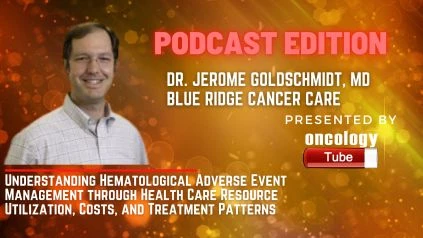Dr. Jerome Goldschmidt graduated from the University of North Carolina School of Medicine with a bachelor of arts in German and a minor in chemistry. At the University of Rochester/Strong Memorial Hospital in Rochester, New York, he completed his medical oncology fellowship. In this video Dr. Goldschmidt discusses Understanding Hematological Adverse Event Management through Health Care Resource Utilization, Costs, and Treatment Patterns of Patients with Extensive-Stage Small Cell Lung Cancer Treated in the Community Oncology Setting.
https://ash.confex.com/ash/2021/webprogram/Paper148057.html
BACKGROUND:
Chemotherapy-induced myelosuppressive hematological adverse events (anemia, neutropenia, and thrombocytopenia) are typical side effects in cancer patients. For patients with advanced stage small cell lung cancer, cytotoxic chemotherapy remains the gold standard of care (ES-SCLC). The expenditures, treatment patterns, and health care resource utilization (HCRU) related with myelosuppressive hematological adverse events (HAEs) among ES-SCLC patients treated with chemotherapy in the community oncology setting were investigated in this study.
METHODS:
From January 1, 2015, to December 31, 2020, data from The US Oncology Network’s iKnowMed electronic health records were used in a retrospective observational analysis. Adult patients with ES-SCLC who started chemotherapy (alone or in combination with immunotherapy) between January 1, 2015 and December 31, 2019, were identified and divided into two trial cohorts: those who developed grade 3 HAE after starting chemotherapy and those who did not. The starting date of chemotherapy was used as the index date. Patients were followed from the index date until December 31, 2020, or until death or the last patient record, whichever happened first. HAEs were discovered using iKnowMed structured data for laboratory values based on the categories for anemia, neutropenia, and thrombocytopenia in the Common Terminology Criteria for Adverse Events v5.0. Both cohorts had their health-care resource consumption, outpatient costs, and treatment patterns assessed. Due to a lack of data, inpatient charges and transfusion costs were not included.
RESULTS:
After starting treatment, 778 individuals developed at least one grade 3 HAE (50.3 percent with grade 3 anemia, 46.0 percent with grade 3 neutropenia, 28.0 percent with grade 4 neutropenia, 33.8 percent with grade 3 thrombocytopenia, 18.1 percent with grade 4 thrombocytopenia). 454 patients (58.4%) of the 778 patients had grade 3 HAEs in two or more lineages (21.3 percent for anemia and neutropenia, 21.0 percent for neutropenia and thrombocytopenia, 20.6 percent for anemia and thrombocytopenia, and 12.2 percent for all 3 lineages). According to test results, 43.1 percent of patients were eligible for RBC transfusions and 3.9 percent for platelet transfusions. Major bleeding episodes were seen in 12.2 percent of individuals. In the HAE without grade 3 cohort, 596 patients were enrolled. The two cohorts had similar demographics and baseline ECOG values (Table 1). In both cohorts, almost all patients (>99%) received first-line chemotherapy at index (about 80% got platinum/etoposide regimen, 15% received platinum/etoposide in conjunction with immunotherapy). When compared to patients without grade 3 HAE, patients with grade 3 HAE had a higher proportion of dose reductions (46.7 percent vs. 32.2 percent), treatment holds (12.7 percent vs. 5.9 percent), and treatment delays (92.3 percent vs. 84.3 percent) after chemotherapy initiation, all of which were p0.001.
Patients with grade 3 HAE had higher total outpatient costs (12 months post-index ($37,613 vs. $31,176, p=0.004) (Table 2). Within 12 months after the index, patients with grade 3 HAE had an average of 10.7 outpatient visits, compared to 7.7 outpatient visits for those without grade 3 HAE (p0.0001). Patients with grade 3 HAE were also more likely to use G-CSF (64.1 percent vs. 57.2 percent, mean number of administrations 3.5 vs. 2.4, mean cost per patient $9864 vs. $8011, all p0.01), ESA (18.6 percent vs. 4.8 percent, 0.7 vs. 0.12 administrations, mean cost per patient $786 vs. $151, all p0.01), and IV hydration (46.0 percent
CONCLUSIONS:
The findings imply that in a community oncology environment, there is a considerable burden of myelosuppressive hematological adverse events among ES-SCLC patients. A significant number of patients had HAEs in two or more lineages. Patients with grade 3 HAE appear to have higher dose reductions, treatment delays, and health-care utilization than those without the condition. Therapies that protect bone marrow from multilineage HAEs may be able to alleviate this load. To properly grasp the full spectrum of HAE management, future study should look into HCRU and cost burden in the inpatient environment.

